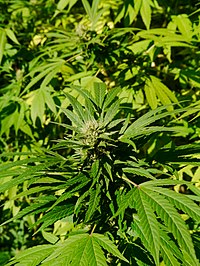
Photo from wikipedia
Demand for cannabinoid is growing, with the global market expected to reach $9.69 billion by 2025. Understanding how chemical composition changes in hemp at different harvest times is crucial to… Click to show full abstract
Demand for cannabinoid is growing, with the global market expected to reach $9.69 billion by 2025. Understanding how chemical composition changes in hemp at different harvest times is crucial to maximizing this industrial crop value. Important compositional changes in three different compound classes (essential oils, cannabinoids, and lipids) from inflorescences (tops), leaves, and stems of hemp (Cannabis sativa L., Finola variety) at different harvesting stages have been investigated. Over 85% of the total extracts from the tops were cannabinoids, while leaves demonstrated the greatest quantities of wax ester and sterols. Essential oil and cannabinoid increased in tops until full flowering (third harvest), reaching 2030 µg g−1 and 39 475 µg g−1, respectively. Cannabinoids decreased at seed maturity (final harvest) to 26 969 µg g−1. This demonstrates the importance of early harvesting to maximize cannabidiol (CBD), which is highly sought after for its therapeutic and pharmacological properties. A total of 21 161 µg g−1 of CBD was extracted from the tops at full flowering (third harvest); however, a significant increase (63%) in the banned psychoactive tetrahydrocannabinol (THC) was observed from budding (157 µg g−1 of biomass) to the full flowering (9873 µg g−1 of biomass). Harvesting the tops after budding is preferable due to the high CBD content and low amounts of THC.
Journal Title: Royal Society Open Science
Year Published: 2022
Link to full text (if available)
Share on Social Media: Sign Up to like & get
recommendations!